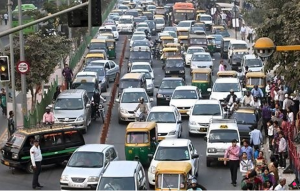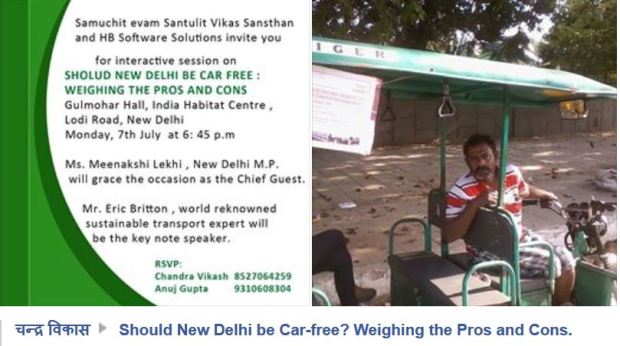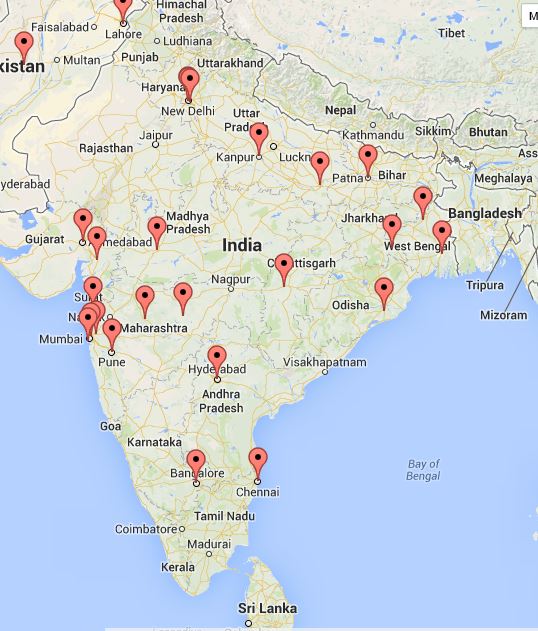 India Streets 2.0 is ready to go. You have access to its full content, simply by clicking START and starting to read. However to get full benefit, you may wish to check out the following user hints.
India Streets 2.0 is ready to go. You have access to its full content, simply by clicking START and starting to read. However to get full benefit, you may wish to check out the following user hints.
Visit the World Streets Vidéothèque: 2009 – 2014
 The Tellus Institute of Boston Massachusetts has recently initiated a collaborative program looking into alternative Urban Mobility Futures which will certainly be of interest to many readers of World Streets. Initial background information on their program along with direct links to the appropriate sites will be found below. But today we thought to see if we might be useful in response to a request from them which has just come in, as follows:
The Tellus Institute of Boston Massachusetts has recently initiated a collaborative program looking into alternative Urban Mobility Futures which will certainly be of interest to many readers of World Streets. Initial background information on their program along with direct links to the appropriate sites will be found below. But today we thought to see if we might be useful in response to a request from them which has just come in, as follows:
With the dawn of a new academic semester for some members of this group, we aim to identify resources (especially video materials) that are useful for classroom use on the general subject of “post-automobility futures.”
No problem: World Streets can be of some help since we have made it a habit over the years to identify, keep track of and share widely particularly interesting videos that will be of use to students, researchers, environmentalists, the media, activists and others wishing…
View original post 687 more words
Happy New Year from Pune: Traffic – Crux of the problem
This New Year’s editorial contributed by Sujit Patwardhan focuses on his home city of Pune, India’s eighth largest city with five million people densely packed into a land area of about 700 sq. km. But despite the vast dimensions of their problems, the potential solutions are basically the same as those encountered by cities around the world that are struggling with these challenges. As Sujit reminds us, the key, the crux, the indispensable thing that will do the job is to apply the strong medicine which most cities and national governments find simply impossible to swallow: namely major curtailing of car access,parking and traffic in the city. And yet, and yet . . .
View original post 970 more words
CFD 2014 City Cycling Self-Audit Organization (Working notes)
WORLD STREETS __ A New Mobility Action Plan for 2022
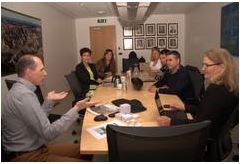 The one point not as yet clear in the provisional program notes developed to now is how, when and by whom exactly does the actual self-audit or benchmarking exercise take place. This is a matter for each city team to work out for themselves, but here are some for suggestions based on our past experience.
The one point not as yet clear in the provisional program notes developed to now is how, when and by whom exactly does the actual self-audit or benchmarking exercise take place. This is a matter for each city team to work out for themselves, but here are some for suggestions based on our past experience.
1. Start here
The usual starting point is to organize a first plenary meeting as early as convenient and convene the various key groups and individuals who know most about cycling their city, and then going step by step through the 20 point questionnaire and discuss what the consensus of the meeting could be concerning each of the benchmarks. (It is useful to make sure that the key documents are distributed in advance so that members of the group will have a chance to reflect on and organize their thoughts on each of the key…
View original post 597 more words
Provisional Guidelines for 2014 State of City Cycling Self-Audit
World Car Free Day 2014: “La femme est l’avenir de l’homme”
Celebrating Bandung’s Car Free Day. Known as “We shot Bandung” Credit: Ikhlasyl Amal.
At a terrible time in the history of mankind, I propose to you this photograph as a message of hope and a silent clue to a better, sweeter future for all. . . agreeing as I do with the poet Louis Aragon when he wrote so long ago: “La femme est l’avenir de l’homme” (“Woman is the Future of Mankind”).
What about this? Let’s get together, you and, I to see what we can do about making this the universal theme of World Car Free Day this year . . . in as many cities and countries around the world as we can. One city at a time.
Your turn!
# # #
Eric Britton
13, rue Pasteur. Courbevoie 92400 France
Bio: Founding editor of World Streets (1988), Eric Britton is an American political scientist, teacher, occasional consultant, and sustainability activist who has observed, learned, taught and worked on missions and advisory assignments on all continents. In the autumn of 2019, he committed his remaining life work to the challenges of aggressively countering climate change and specifically greenhouse gas emissions emanating from the mobility sector. He is not worried about running out of work. Further background and updates: @ericbritton | http://bit.ly/2Ti8LsX | #fekbritton | https://twitter.com/ericbritton | and | https://www.linkedin.com/in/ericbritton/ Contact: climate@newmobility.org) | +336 508 80787 (Also WhatApp) | Skype: newmobility.)
Signals, Perceptions, Behaviour: Questions, Blurs & Clues
In transportation circles, most often in Europe and North America but not uniquely there, we often  hear the term “behavior modification”, which is usually brandished as something that somebody else has to learn to do and cope with. More often than not this matter of behavior modification crops up when it comes to considering how, when and where people drive cars. But we can also hear about it with reference to the behavior (and the modification thereof) of pedestrians, cyclists, commuters and other drivers and street denizens. And as we can see from the results, this matter of behavior and modification turns out to be quite a challenge. We are opening up the pages of World Streets and others of our projects and work to these discussions over the course of 2014.
hear the term “behavior modification”, which is usually brandished as something that somebody else has to learn to do and cope with. More often than not this matter of behavior modification crops up when it comes to considering how, when and where people drive cars. But we can also hear about it with reference to the behavior (and the modification thereof) of pedestrians, cyclists, commuters and other drivers and street denizens. And as we can see from the results, this matter of behavior and modification turns out to be quite a challenge. We are opening up the pages of World Streets and others of our projects and work to these discussions over the course of 2014.
– – – > Click HERE for more on behavior and choice from World Streets
OYE DELHI! PLEASE MIND THE TRAFFIC
 Zinnia Sidhu writes from Delhi
Zinnia Sidhu writes from Delhi
Delhi’s mindless traffic causing breakups since Papu learnt how to drive. The BIG WHITE elephant in the city. Oho! Not Papu, the traffic silly. The unnecessary evil. I genuinely believe that Delhiiets fortunately or unfortunately spend at least 50% of their waking hours in the car listening to Radio Mirchi, while simultaneously banging their heads on the steering wheel, texting, taking Instagram worthy shots, and not to mention swearing once in a while.
Picture this.
The Ring Road’s total length is 48km and is a six-lane carriageway. This was designed to carry about 75,000 vehicles a day. But the road carries 1.6 lakh vehicles per day and is expected to carry about 4 lakh vehicles by 2016!
Should new Delhi be car-free? Weighing the pros and cons
Latest News From Streets of India
2007 Archives: Shared Public Bicycles for Pune
From the archives: In 2007 architect, social activist and filmmaker Manisha Gutman travelled to Paris with a small team to have a look at the city’s new and highly innovational public bicycle system to see if there might be opportunities and lessons for Pune in the Paris experience. She sat down with Eric Britton of EcoPlan and the New Mobility Agenda so see if there might be a fit after all. This informal video reports on that conversation.
Dinesh Mohan: On The Streets of India, v. 2.0
– Indian Institute of Technology Delhi. New Delhi. 22 June 2014
In response to your invitation to comment on the possible new launching of the Streets of India 2.0:
1. I think you should [continue on this] because a lot of people seem to get information from such sources.
2. Many expats out of India and other well wishers want to help their “unfortunate brothers and sisters” living here in a “corrupt inefficient land” They want us to get our act together and reproduce an America or Europe in India. I guess that’s not going to happen. Continue reading
The Spirit Of Mumbai Through Local Trains
World Streets and the Fine Art of Governance
WORLD STREETS __ A New Mobility Action Plan for 2022
 In order to help the reader find appropriate articles and references on identified important themes from our commodious library of postings and comments, World Streets offers a handful of Search Engines of different types. One of these that you will see to your immediate right here, allows the reader to search according to various keyed topic areas, of which approximately one hundred have been identified thus far. One of the more consulted of these categories is that of “governance”.
In order to help the reader find appropriate articles and references on identified important themes from our commodious library of postings and comments, World Streets offers a handful of Search Engines of different types. One of these that you will see to your immediate right here, allows the reader to search according to various keyed topic areas, of which approximately one hundred have been identified thus far. One of the more consulted of these categories is that of “governance”.
View original post 232 more words
Student Road Safety Campaign IIT Delhi
A few weeks ago four of our friends lost their lives in a horrific car crash on the road to Jaisalmer. A few weeks later another three were victims of a motorcycle crash in our neighboring institution, the Jawaharlal Nehru University. These events have prompted deep introspection on our campus and some of us met last week to discuss what we can do to do move toward safer roads and traffic management in India.
Who is reading India Streets in India . . .
June 2014 – Invitation and Letter from the Editor
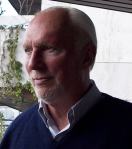 After a lively start in 2010 the Streets of India is waiting for partners to appear to collaborate in making this site a useful resource for the transportation/environment community in India. If you have ideas for us, please click Contact on the top menu . In the meantime, check out the Facebook Discussion Group at https://www.facebook.com/IndiaStreets. – – – > Click here to access Facebook Discussions
After a lively start in 2010 the Streets of India is waiting for partners to appear to collaborate in making this site a useful resource for the transportation/environment community in India. If you have ideas for us, please click Contact on the top menu . In the meantime, check out the Facebook Discussion Group at https://www.facebook.com/IndiaStreets. – – – > Click here to access Facebook Discussions
India Streets is one of the World Streets family of collaborative problem-solving and networking projects addressing transport/environment issues in different parts of the world;. You may want to check out the main related program sites as follows: Continue reading
What is an Equity-Based Transport System ?
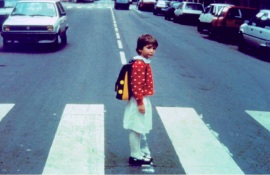 We understand that in the transport sector this is not a well known or much appreciated concept, at least in the positive sense we are trying to develop here, so we are making every effort to clarify. I was discussing this program the other day with a bright young woman from the Emirates who is on an MBA program here, who smiled at me indulgently as I asked her views and said: ‘Don’t you understand Eric, life is not fair”. That gives us, I would say, a good point of departure.
We understand that in the transport sector this is not a well known or much appreciated concept, at least in the positive sense we are trying to develop here, so we are making every effort to clarify. I was discussing this program the other day with a bright young woman from the Emirates who is on an MBA program here, who smiled at me indulgently as I asked her views and said: ‘Don’t you understand Eric, life is not fair”. That gives us, I would say, a good point of departure.
The first step in this process is to see if we can create a common understanding of our topic and the strategy that goes with it – bearing in mind the fact that in most cities in the world, probably all of them to be perfectly frank and accurate, our transportation arrangements are not equitable, indeed far from it. There are winners and losers from the present mobility arrangements, worse here, perhaps a bit better there.

